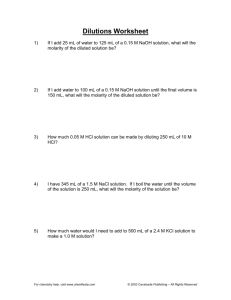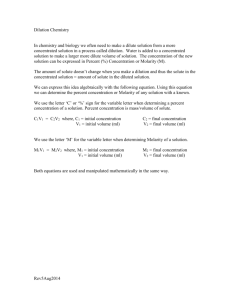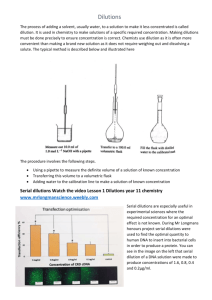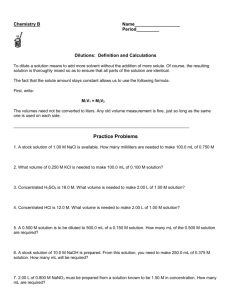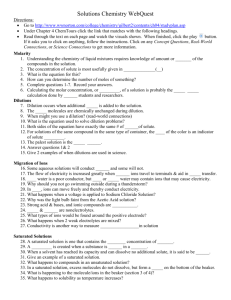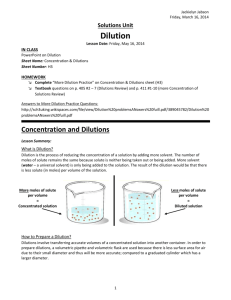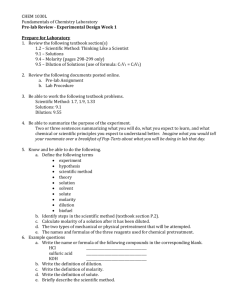03) Concentration - DILUTIONS - chem30-wmci
advertisement
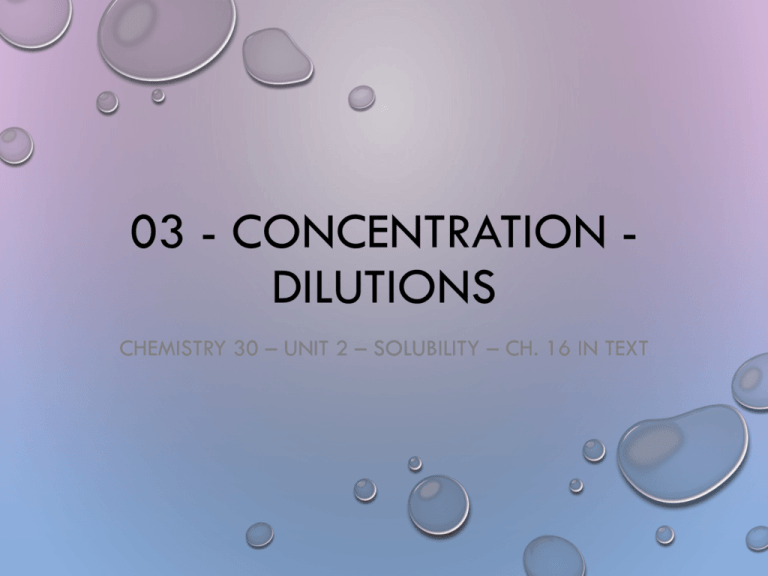
03 - CONCENTRATION DILUTIONS CHEMISTRY 30 – UNIT 2 – SOLUBILITY – CH. 16 IN TEXT STOCK SOLUTIONS • A common situation in a chemistry laboratory occurs when a solution of a particular concentration is desired, but only a solution of greater concentration is available: this is called a stock solution. WHAT IS A DILUTION? • To dilute a solution means to add more solvent without the addition of more solute. • You may have heard it referred to as “watering down” • This statement is somewhat accurate, as long as your solvent actually is water • Of course, the resulting solution is thoroughly mixed so as to ensure that all parts of the solution are homogenous. WE CAN DILUTE A SOLUTION BY ADDING WATER TO IT: BEFORE DILUTION: M1 = INITIAL MOLES OF SOLUTE AFTER DILUTION: M2 = FINAL MOLES OF SOLUTE FROM PREVIOUS SLIDE… • NOTICE THAT WE DID NOT ADD ANY MORE SOLUTE AT ALL • THE NUMBER OF MOLES WILL NOT CHANGE. • THE VOLUME CHANGES, AND ALSO THE CONCENTRATION. Initial moles of solute …is equal to Final moles of solute DILUTION EQUATION: • The fact that the solute amount stays constant allows us to develop calculation techniques. First, we write: 𝑚𝑜𝑙𝑏𝑒𝑓𝑜𝑟𝑒 𝑑𝑖𝑙𝑢𝑡𝑖𝑜𝑛 = 𝑚𝑜𝑙𝑎𝑓𝑡𝑒𝑟𝑑𝑖𝑙𝑢𝑡𝑖𝑜𝑛 • From the definition of molarity, we know that the moles of solute equals the molarity times the volume. 𝑚𝑜𝑙 = 𝑀 ∗ 𝑉 • So we can substitute equation, like this: 𝑀1 𝑉1 = 𝑀2 𝑉2 • M1V1 means the molarity and the volume of the original solution • M2V2 means the molarity and the volume of the second solution. EXAMPLE #1 • 53.4 mL of a 1.50 M solution of NaCl is on hand, but you need some 0.800 M solution. How many mL of 0.800 M can you make? • Using the dilution equation, we write: 𝑀1 𝑉1 = 𝑀2 𝑉2 1.50𝑀 00534𝐿 = 0.800𝑀 𝑉2 𝑉2 1.50𝑀 00534𝐿 = 0.800𝑀 𝑉2 = 0.100L=100.mL=1.00∗102 𝑚𝐿 • Any old volume measurement is fine, just so long as the same one is used on each side. EXAMPLE #2 • 100.0 mL of 2.500 M KBr solution is on hand. You need 0.5500 M. What is the final volume of solution which results? • Placing the proper values into the dilution equation gives: 𝑀1 𝑉1 = 𝑀2 𝑉2 (2.500 mol/L) (0.1000 L) = 0.5500 mol/L 𝑉2 𝑉2 (2.500 M) (0.1000 L) = 0.5500 M 𝑉2 = 0.4545L=454.5mL SERIAL DILUTIONS • The dilution equation is fairly easy to understand – we shouldn’t have any trouble calculating new or desired concentrations or volumes • Sometimes however, we will calculate out a value that is too small or unrealistic – this makes it difficult to measure in a practical lab-like setting SERIAL DILUTIONS - EXAMPLE • How could we prepare 200.0 mL of .010 M HCl from 10. M HCl? • Calculate the missing value using the dilution equation • M1v1 = M2v2 10. ( vi ) = 200.0 (.010) • v1 = 0.20 mL • It is unrealistic for us to measure .20 mL so we do a series of dilutions so we can maintain our accuracy SERIAL DILUTIONS - EXAMPLE • How do we solve this? • Step 1: First pick a practical dilution into an appropriately small volume. This is usually determined by the tools that you have in the lab. • For example use 10. ml into 200.0 ml • M1V1 = M2V2 • 10.M ( 10.mL ) = ( M2 ) 100.mL M2 = 1.0 M • Step 2: Now you have a 1.0 molar solution so redo the math to find how much of our NEW solution we need to make the concentration we want. • M1V1 = M2V2 • (1.0)v1 = 200.0mL ( .010 ) v1 = 2.0 mL • 2.0 mL is a much more reasonable amount to measure than 0.20 mL SERIAL DILUTIONS - EXAMPLE • If 2.0 mL is still too small and you don't have the equipment to do it, continue to dilute: • Step 1: Do the 10. ml into 100. ml again; this time your initial concentration will be 1.0 M • M1v1 = M2v2 • (1.0) 10. = (M2) 100. M2 = .10 M • Step 2: Now you have a .10 molar solution so redo the math • M1v1 = M2v2 • (.10)v1 = 200.0 (.010) v1= 20. mL • 20. mL is even easier than 2.0 mL to measure accurately SERIAL DILUTION VISUAL Stock Solution Volumetric Pipette M1 = 10.M V1 = 10.0mL X 1st Dilution M2 = ?M Volumetric Flask V2 = 100.0mL M1V1=M2V2 Gives us 1.0M 1st Dilution M1 = 1.0M Graduated Pipette V1=?mL M1V1=M2V2 Gives us 2.0mL X 2nd Dilution M2 = 0.01M Volumetric Flask V2 = 200.0mL

